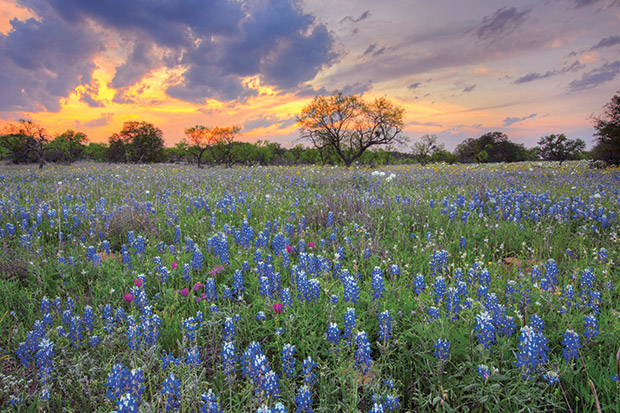
Texas bluebonnets and winecups in Mason County. (Photo © Rob Greebon)
Photo Garden
See many more breathtaking wildflower photos in the April 2016 print edition of Texas Highways magazine. If you’re not a subscriber, find a copy at a newsstand near you.
Wildflowers, Abridged
Among the qualities of Texas that we treasure most are its vastness and natural diversity—and the beautiful variety of wildflowers that flourish in the state’s far-flung regions. But it can be difficult to embark on the type of road trip required to see each of the state’s distinct environments in person.
Don’t be discouraged! Texas Highways is once again compiling stunning images of these scattered beauties for our annual wildflower photo exhibit at the Lady Bird Johnson Wildflower Center. April 30-May 30, the Wild-
flower Center’s McDermott Learning Center will showcase flowery images from across the state, including from several photographers featured in this issue. The Texas Highways photo exhibit is part of the Wildflower Center’s annual Wildflower Days (March 14-May 31). The lineup of springtime activities and exhibits includes the Family Wildflower Cave Tour on March 26; Spring Native Plant Sale April 8-10; a Nature/Wildflower Photography workshop April 30; National Wildflower Week walks and talks May 2-8; and so much more. Call 512/232-0100.Our thanks to Minette Marr, plant conservationist, and Joe Marcus, program coordinator, at the Lady Bird Johnson Wildflower Center for their help with wildflower information and photo identification.
Some wildflowers grow all over the state, while others appear in a more limited fashion, perhaps only blooming in dry, desert areas or in moist areas along rivers and creeks. The state’s various landscapes, from the Piney Woods to the Trans-Pecos, inhabit distinctive soil conditions and climates, which influence the local plants. For example, the Blackland Prairie—a strip of deep, fertile soil that runs up and down east-central Texas—is a favorite for such wildflowers as Indian paintbrush, firewheel, and primrose.
Many of us claim an attachment to at least one wildflower—one with a beauty or fragrance that triggers associations of memorable places, faces, and happenings. Such favorites are personal—tailored by the intricacies of our individual experiences and as diverse as the splashes of color across a Washington County pasture at the height of spring.
Still, some wildflowers loom particularly large in certain parts of the state, and with the help of our expert friends at the University of Texas at Austin’s Lady Bird Johnson Wildflower Center, we’ve selected symbolic wildflowers for seven regions across Texas. We’ve also included recommendations for fun activities and attractions to complement your springtime wildflower excursions. So whether you prefer to stick close to home or venture afar for a statewide wildflower trip, we wish you sunny skies and beautiful blooms.
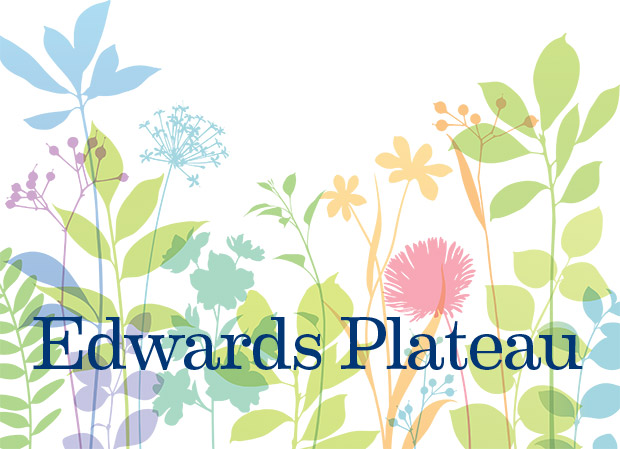
Prairie verbena
(Glandularia bipinnatifida)
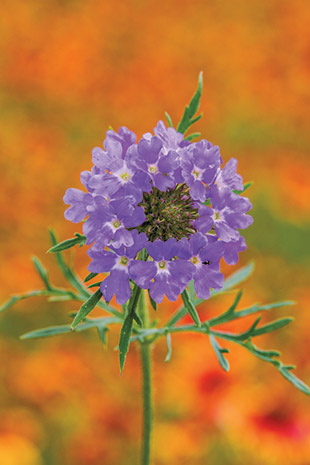
Prairie Verbena (Photo © Steven Schwartzman)
Stay: The Treetop Lodge, just east of Leakey, sleeps 16 people and includes a covered deck high in a cypress tree above the Frio River. Additional decks overlook the river, and a patio provides access to the water and a rope swing. Call 830/966-2320.
Eat: The unassuming but locally famous Mac and Ernie’s Roadside Eatery in Tarpley serves entrées like fried catfish and lamb chops, as well as such playful riffs on the good ol’ hamburger as a cabrito burger and an antelope burger. Call 830/562-3727.
Play: Take Hill Country Adventures’ two- to four-hour guided Champion Big Trees Tour to see some of the largest and oldest trees in Texas, including several state and national champion trees. Trees on the tour include Texas persimmon, evergreen sumac, honey mesquite, and a 96-foot-tall bald cypress. Call 830/966-2320.
Big Bend bluebonnet
(Lupinus havardii)
The Texas Legislature first designated the Lupinus subcarnosus variety of bluebonnet as the official state flower in 1901. These grow about six to 16 inches tall and sport bright-blue, pea-shaped petals. In 1971, however, the Legislature extended the official flower designation to all six Lupinus species, including the Big Bend bluebonnet. This species grows three to four feet tall with flowers on the upper four to eight inches of the stem. True
to its name, it prefers the Trans-Pecos region’s dry alluvium or fine talus soils, and it requires plenty of sun. Alluvium is loose sediment deposited by running water and is often found in river or creek beds.
Spot these impressive bluebonnets along the roadsides and on hiking trails that cross or follow creek beds. Try the gravelly creek on Cinco Tinajas Trail in Big Bend Ranch State Park or Santa Elena Canyon Trail in Big Bend National Park. In this part of Texas, you can also see the blooms of yucca, mountain laurel, cactus, and huisache.
Stay: Perched on a hillside in the Terlingua ghost town, La Posada Milagro Guesthouse has four cozy rooms created from stacked rock ruins. A large patio features an outdoor kitchen, fire pit, and stunning views of the mountains of Big Bend and Mexico. Espresso y Poco Mas, the on-site coffee shop, serves made-from-scratch breakfasts and lunches. Call 432/371-3044.
Play: For a different perspective of the dramatic Big Bend landscape, try a boat. Local outfitters offer half-day or longer Rio Grande float trips through the rugged mountains, where guides point out geologic formations and desert plants and animals. Many also offer guided hiking, mountain biking, and jeep tours.
Eat: Terlingua’s Starlight Theatre, originally built as a movie house for Chisos Mining Company employees, became an eclectic restaurant and bar in 1991. After a day of taking in wildflowers and the desert mountains, refuel with a wild axis burger, topped with roasted green chiles and Swiss cheese, and a prickly pear margarita, made with tequila and prickly pear nectar. Call 432/371-3400.
Texas bluebonnet
(Lupinus texensis)
The familiar Texas bluebonnet has larger, more sharply pointed leaves than its cousins, and more flower heads, too—clusters of up to 50 fragrant petals with a white tip. One of six species dubbed the state flower of Texas, this bluebonnet blooms from Louisiana to West Texas and down to San Luis Potosí in northern Mexico. In Texas, it occurs most abundantly in the Blackland Prairie and Edwards Plateau, thriving in sunny prairies and open fields with dry limestone, sandy or clay loam, and calcareous or caliche soil.
The Brenham area is a favorite of bluebonnet aficionados for its pastoral landscape of rolling hills and prairies, adorned by rustic barns, cattle herds, and fields of wildflowers. April 9-10, the Bluebonnet Festival in Chappell Hill, located about 10 miles east of Brenham, celebrates the state flower and provides a worthy reason to explore the area. Farther west in the Hill Country, the Highland Lakes town of Burnet claims the title of “Bluebonnet Capital of Texas” and hosts its own Bluebonnet Festival on April 8-10. Both events practically guarantee swaths of the flowers, along with Indian paintbrush, Texas yellow star, and Engelmann’s daisies.
Stay: Down a quiet side street off Chappell Hill’s main drive, Southern Rose Ranch Bed and Breakfast offers two guest suites and a spacious outdoor kitchen surrounded by stone walls with a fireplace and hot tub. Enjoy a gourmet breakfast made with the ranch’s fresh eggs and herbs. Call 979/251-7871.
Eat: Step back into the 1950s at the Southern Flyer Diner, located at the Brenham Municipal Airport, complete with a jukebox, waitresses in poodle skirts, and a view of airplanes coming and going. This lunch spot is known for treats like malts, old-fashioned root beer floats, and milkshakes. Rumor has it that pilots will fly through bad weather for the milkshakes. Call 979/836-5462.
Play: Saddle up at Texas Ranch Life, an 1,800-acre working ranch and resort, for a two-hour horseback ride (by reservation) through rolling hills, pecan bottoms, and fields awash in bluebonnets, winecups, aster, and more. Call 979/865-3649.
Spotted beebalm
(Monarda punctata)
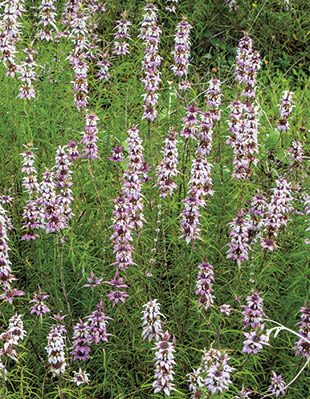
Spotted Beebalm (Photo © Steven Schwarzman)
The Trinity Forks Chapter of the Native Plant Society of Texas reports that beebalm can be found throughout the LBJ Grasslands, which straddles US 287 north of Decatur. Look for the flowers from roads and trails through any open, sunny area.
In the Johnson Branch of Ray Roberts Lake State Park, beebalm blooms along many of the roadsides, along trails in the Walnut and Juniper camping loops, and on the Vanishing Prairie Trail, says Ranger Danielle Bradley. Open areas in the state park are also home to bluebonnets, gayfeather, Indian paintbrush, black-eyed Susan, antelope horns, meadow pink, and others.
Stay: Two wings of rooms at Lantana Resort in Ray Roberts Lake State Park overlook cedar, post oak, and black oak trees on the shores of the lake. A popular destination for events, the resort also provides its visitors with free entry to the state park. Call 940/686-0261.
Play: This part of North Texas boasts one of the greatest concentrations of horse farms in the United States—more than 300. See them on self-guided driving tours or join one of Denton’s “Behind-the-Scenes Horse Country Tours” by bus on April 2 or May 7, and in the fall on October 1, November 5, and December 3. Call 940/382-7895.
Eat: In Denton, head for the Austin Street Truck Stop for a wide selection of food-truck choices, including the Waffle Wagon, Vietnamese cuisine at the Pickled Carrot, sandwiches at Hoagieslinger, Korean fusion by Say Kimchi, tacos at Flatlanders Taco Company, and barbecue at Coochie’s BBQ and Tha Smokin Chef. Check the website for the trucks’ schedules. Call 940/218-1401.
Flowering Dogwood
(Cornus florida)
Flowering dogwood trees reach heights of 20 feet, with a spreading crown and showy white and pink blooms. In addition to spring flowers, dogwoods sport red summer fruit and bright scarlet autumn foliage.
Dogwoods grow in thickets, stream banks, and dry uplands along the entire East Coast, westward to the Mississippi River and in Arkansas, Kansas, Oklahoma, and East Texas. The city of Palestine celebrates its abundant dogwoods with the annual Dogwood Trails Celebration in late March and early April. Another good place to see the beautiful white blooms is around Huntsville. Drive Park Road 40 in Huntsville State Park or walk its 1.78-mile Dogwood Trail. The park has 21 miles of trails, including a trailhead to access the 128-mile Lone Star Trail. Look for American beautyberry and Turk’s cap here, too.
Stay: The cabins at rustic Bethy Creek Resort come equipped with a kitchen and provide scenic views of tree-lined Lake Livingston. Book a cabin or a campsite for easy access to the resort’s plethora of lake activities—a sandy beach, fishing pier, boat slips, and boat rentals. Bethy Creek is about 11 miles from Huntsville, and you’re likely to see dogwoods on the drive out. Call 800/537-6251.
Play: The 128-mile Lone Star Hiking Trail through Sam Houston National Forest, from Lake Conroe to near Cleveland, takes in forest, swamps, and wildflowers. With multiple access points, the trail provides routes of a few hours up to a day or more. Over the years, students and Boy Scouts have planted wildflowers along the trail, including bluebonnets, Indian blankets, black-eyed Susan, purple coneflower, and others.
Eat: The menu at Farmhouse Cafe in Huntsville contains a wide selection of down-home favorites, but don’t miss the fresh rolls or such daily blue-plate specials as meatloaf, chicken and dumplings, and pot roast. The Farmhouse also bakes pies and cakes, available by the slice
or whole to take home. Call 936/435-1450.
Huisache daisy
(Amblyolepis setigera)
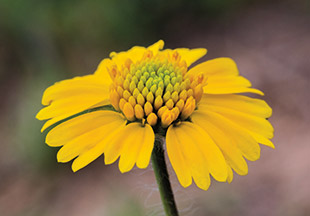
Huisache Daisy (Photo © Steven Schwarzman)
Find huisache daisies at Goliad State Park and Historic Site, especially in the field near Cardinal’s Haven Bird Blind and the Longhorn tent camping area, as well as along the road leading to the Jacales camping area. Look for more blooms alongside US 183, just after crossing the San Antonio River, in front of historic Presidio la Bahía. Phlox, coreopsis, and rose prickly poppies bloom here as well.
Stay: Built in 1749, Presidio la Bahía is a National Historic Landmark and one of the finest extant examples of a Spanish frontier fort. Spanish soldiers stationed here fought the British along the Gulf Coast during the American Revolution and, in the lead-up to the Texas Revolution, Texans captured the fort from Mexico in 1835. Spend the night immersed in history in The Quarters, a part of the presidio that once housed Mexican officers and Catholic priests. Sleeps four. Call 361/645-3752.
Play: Experience the San Antonio River on the Goliad Paddling Trail, a 6.6-mile route from US 59 to a take-out in Goliad State Park. The narrow, winding stream passes through woodlands of cypress, oak, and pecan trees that support a variety of birdlife including herons, kingfishers, hawks, phoebes, and turkeys.
Eat: The Hanging Tree Restaurant looks out on Goliad’s courthouse square and a magnificent oak tree, from which several oxcart operators were hanged in 1857 for murdering rival freight haulers in a conflict known as the Cart Wars. Dine from a menu of hearty comfort food like chicken-fried steak, fried chicken, and hamburgers amid rustic décor such as hunting trophies. Open for lunch and dinner. Call 361/645-8955.
Tahoka daisy
(Machaeranthera tanacetifolia)
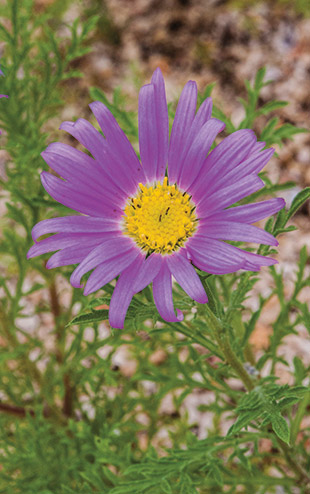
Tahoka Daisy (Photo by Steven Schwartzman)
Tahoka daisies brighten the floor of Palo Duro Canyon, along with Indian blanket, American basketflower, sunflower, paper-flower, blackfoot daisy, sand sage, yucca, and prickly pear. The trails of Palo Duro Canyon State Park offer prime opportunities to look for blooms. Try the milelong Paseo del Rio trail, which follows a fork of the Red River, or the Pioneer Nature Trail, a half-mile loop.
Stay: In the 1930s, the Civilian Conservation Corps built three rock cabins on the rim of Palo Duro Canyon. Each features unlimited scenic views of the dramatic landscape below and sleeps four. Call 806/488-2227; www.tpwd.texas.gov/state-parks/palo-duro-canyon.
Play: In Canyon, the Panhandle-Plains Historical Museum covers this region’s very busy past 14,000 years. Experience the life-size Pioneer Town, one of the Southwest’s finest art collections, and exhibits
on paleontology, geology, archeology, textiles, windmills, and transportation. Call 806/651-2244.
Eat: Palace Coffee Company, located in the historic Smith Building on Canyon’s town square, serves up coffee and espresso drinks made from custom-roasted beans. Try the Cause Latte; for each one sold, the shop gives $1 to a community nonprofit. Call 806/476-0111, ext. 2.














